《食品加工原理》课程PPT教学课件(福建农林大学)Chapter 3 PASTEURIZATION AND BLANCHING
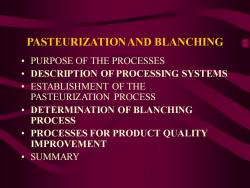
PASTEURIZATION AND BLANCHING • PURPOSE OF THE PROCESSES • DESCRIPTION OF PROCESSING SYSTEMS • ESTABLISHMENT OF THE PASTEURIZATION PROCESS • DETERMINATION OF BLANCHING PROCESS • PROCESSES FOR PRODUCT QUALITY IMPROVEMENT • SUMMARY
PASTEURIZATION AND BLANCHING • PURPOSE OF THE PROCESSES • DESCRIPTION OF PROCESSING SYSTEMS • ESTABLISHMENT OF THE PASTEURIZATION PROCESS • DETERMINATION OF BLANCHING PROCESS • PROCESSES FOR PRODUCT QUALITY IMPROVEMENT • SUMMARY

Vocabulary • pasteurization blanching • mild \severe \batch-type \continuous • brucellosis tuberculosis Salmonella Listeria • enzyme inactivation • plate heat exchanger\ \a flow diversion valve (FDV) \cooling medium\ \high temp.- short-time (HTST) \ \ultra-high-temperature (UHT) \\conveyor tunnel
Vocabulary • pasteurization blanching • mild \severe \batch-type \continuous • brucellosis tuberculosis Salmonella Listeria • enzyme inactivation • plate heat exchanger\ \a flow diversion valve (FDV) \cooling medium\ \high temp.- short-time (HTST) \ \ultra-high-temperature (UHT) \\conveyor tunnel
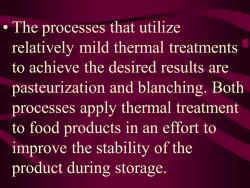
• The processes that utilize relatively mild thermal treatments to achieve the desired results are pasteurization and blanching. Both processes apply thermal treatment to food products in an effort to improve the stability of the product during storage
• The processes that utilize relatively mild thermal treatments to achieve the desired results are pasteurization and blanching. Both processes apply thermal treatment to food products in an effort to improve the stability of the product during storage
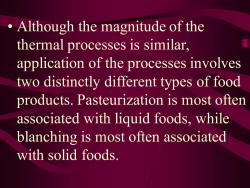
• Although the magnitude of the thermal processes is similar, application of the processes involves two distinctly different types of food products. Pasteurization is most often associated with liquid foods, while blanching is most often associated with solid foods
• Although the magnitude of the thermal processes is similar, application of the processes involves two distinctly different types of food products. Pasteurization is most often associated with liquid foods, while blanching is most often associated with solid foods

• The magnitude of thermal treatment used for both processes is not sufficient to establish storage stability at room temperature. The criteria utilized in establishing these modest thermal treatments are rather specific and are different for different food commodities
• The magnitude of thermal treatment used for both processes is not sufficient to establish storage stability at room temperature. The criteria utilized in establishing these modest thermal treatments are rather specific and are different for different food commodities

Purpose of Pasteurization Processing • Pasteurization is a mild thermal process applied to a liquid food to increase the product shelf life during refrigeration and to destroy vegetative pathogens (brucellosis and tuberculosis), Salmonella and Listeria. • In fruit juice ,to inactivate enzymes
Purpose of Pasteurization Processing • Pasteurization is a mild thermal process applied to a liquid food to increase the product shelf life during refrigeration and to destroy vegetative pathogens (brucellosis and tuberculosis), Salmonella and Listeria. • In fruit juice ,to inactivate enzymes
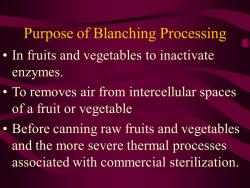
Purpose of Blanching Processing • In fruits and vegetables to inactivate enzymes. • To removes air from intercellular spaces of a fruit or vegetable • Before canning raw fruits and vegetables and the more severe thermal processes associated with commercial sterilization
Purpose of Blanching Processing • In fruits and vegetables to inactivate enzymes. • To removes air from intercellular spaces of a fruit or vegetable • Before canning raw fruits and vegetables and the more severe thermal processes associated with commercial sterilization
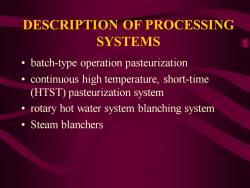
DESCRIPTION OF PROCESSING SYSTEMS • batch-type operation pasteurization • continuous high temperature, short-time (HTST) pasteurization system • rotary hot water system blanching system • Steam blanchers
DESCRIPTION OF PROCESSING SYSTEMS • batch-type operation pasteurization • continuous high temperature, short-time (HTST) pasteurization system • rotary hot water system blanching system • Steam blanchers
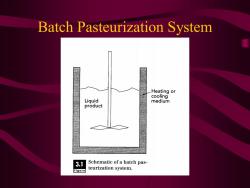
Batch Pasteurization System
Batch Pasteurization System
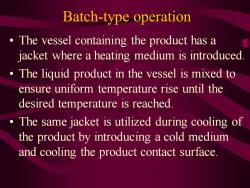
Batch-type operation • The vessel containing the product has a jacket where a heating medium is introduced. • The liquid product in the vessel is mixed to ensure uniform temperature rise until the desired temperature is reached. • The same jacket is utilized during cooling of the product by introducing a cold medium and cooling the product contact surface
Batch-type operation • The vessel containing the product has a jacket where a heating medium is introduced. • The liquid product in the vessel is mixed to ensure uniform temperature rise until the desired temperature is reached. • The same jacket is utilized during cooling of the product by introducing a cold medium and cooling the product contact surface
按次数下载不扣除下载券;
注册用户24小时内重复下载只扣除一次;
顺序:VIP每日次数-->可用次数-->下载券;
- 《食品加工原理》课程PPT教学课件(福建农林大学)Chapter 2 THERMAL PROCESSING PRINCIPLES.ppt
- 《食品加工原理》课程PPT教学课件(福建农林大学)Chapter 1 INTRODUCTION.ppt
- 天津农学院:《食品工艺学》课程教学资源(实验指导)食品工艺学实验任务书(共七章).doc
- 河南农业大学:《食品工艺学》课程教学资源(教案讲义)第五篇 软饮料工艺学.doc
- 河南农业大学:《食品工艺学》课程教学资源(PPT课件)第五篇 软饮料工艺学 5.5 第五章 瓶装水饮料.ppt
- 河南农业大学:《食品工艺学》课程教学资源(PPT课件)第五篇 软饮料工艺学 5.4 第四章 植物蛋白饮料.ppt
- 河南农业大学:《食品工艺学》课程教学资源(PPT课件)第五篇 软饮料工艺学 5.3 第三章 果蔬汁饮料.ppt
- 河南农业大学:《食品工艺学》课程教学资源(PPT课件)第五篇 软饮料工艺学 5.2 第二章 碳酸饮料.ppt
- 河南农业大学:《食品工艺学》课程教学资源(PPT课件)第五篇 软饮料工艺学 5.1 第一章 软饮料用原辅材料.ppt
- 河南农业大学:《食品工艺学》课程教学资源(教案讲义)第四篇 果蔬食品加工学.doc
- 河南农业大学:《食品工艺学》课程教学资源(PPT课件)第四篇 果蔬食品加工学 4.4 第四章 蔬菜腌制工艺.ppt
- 河南农业大学:《食品工艺学》课程教学资源(PPT课件)第四篇 果蔬食品加工学 4.3 第三章 果蔬干制工艺.ppt
- 河南农业大学:《食品工艺学》课程教学资源(PPT课件)第四篇 果蔬食品加工学 4.2 第二章 果蔬糖制工艺.ppt
- 河南农业大学:《食品工艺学》课程教学资源(PPT课件)第四篇 果蔬食品加工学 4.1 第一章 果蔬罐头工艺.ppt
- 河南农业大学:《食品工艺学》课程教学资源(教案讲义)第三篇 面制食品工艺学.doc
- 河南农业大学:《食品工艺学》课程教学资源(PPT课件)第三篇 面制食品工艺学 3.3.4 第三章 焙烤食品工艺(四).ppt
- 河南农业大学:《食品工艺学》课程教学资源(PPT课件)第三篇 面制食品工艺学 3.3.3 第三章 焙烤食品工艺(三).ppt
- 河南农业大学:《食品工艺学》课程教学资源(PPT课件)第三篇 面制食品工艺学 3.3.2 第三章 焙烤食品工艺(二).ppt
- 河南农业大学:《食品工艺学》课程教学资源(PPT课件)第三篇 面制食品工艺学 3.3.1 第三章 焙烤食品工艺(一).ppt
- 河南农业大学:《食品工艺学》课程教学资源(PPT课件)第三篇 面制食品工艺学 3.2.2 第二章 传统面制食品工艺(二).ppt
- 《食品加工原理》课程PPT教学课件(福建农林大学)Chapter 4 COMMERCIAL STERILIZATION.ppt
- 《食品加工原理》课程PPT教学课件(福建农林大学)Chapter 5 REFRIGERATED STORAGE.ppt
- 《食品加工原理》课程PPT教学课件(福建农林大学)Chapter 6 FREEZING AND FROZEN-FOOD STORAGE.ppt
- 《食品加工原理》课程PPT教学课件(福建农林大学)Chapter 7 LIQUID CONC.ppt
- 《食品加工原理》课程PPT教学课件(福建农林大学)Chapter 8 DEHYDRATION.ppt
- 《食品加工原理》课程PPT教学课件(福建农林大学)Chapter 9 OTHER SEPARATION PROCESSES.ppt
- 《食品工艺学》课程电子教案(PPT教学课件)绪论、第一章 罐头食品工艺.ppt
- 《食品工艺学》课程电子教案(PPT教学课件)第二章 软饮料工艺.ppt
- 《食品工艺学》课程电子教案(PPT教学课件)第三章 糕点食品工艺.ppt
- 《食品工艺学》课程电子教案(PPT教学课件)第四章 糖果食品工艺.ppt
- 《食品工艺学》课程电子教案(PPT教学课件)第五章 酒类生产及酱油、食醋、酸奶的制作.ppt
- 《食品工艺学》课程电子教案(PPT教学课件)第六章 脱水食品工艺.ppt
- 《食品工艺学》课程电子教案(PPT教学课件)第七章 食品冷加工工艺.ppt
- 江南大学:《食品工艺学》课程教学资源(PPT课件)第一章 绪论(主讲:夏文水、陈洁、许学勤、陶谦).ppt
- 江南大学:《食品工艺学》课程教学资源(PPT课件)第二章 食品的脱水加工.ppt
- 江南大学:《食品工艺学》课程教学资源(PPT课件)第三章 食品的热处理与杀菌.ppt
- 江南大学:《食品工艺学》课程教学资源(PPT课件)第四章 食品的冷冻保藏.ppt
- 江南大学:《食品工艺学》课程教学资源(PPT课件)第五章 食品的腌渍发酵和烟熏处理.ppt
- 江南大学:《食品工艺学》课程教学资源(PPT课件)第六章 食品的化学保藏.ppt
- 江南大学:《食品工艺学》课程教学资源(PPT课件)第七章 食品的辐射保藏.ppt
